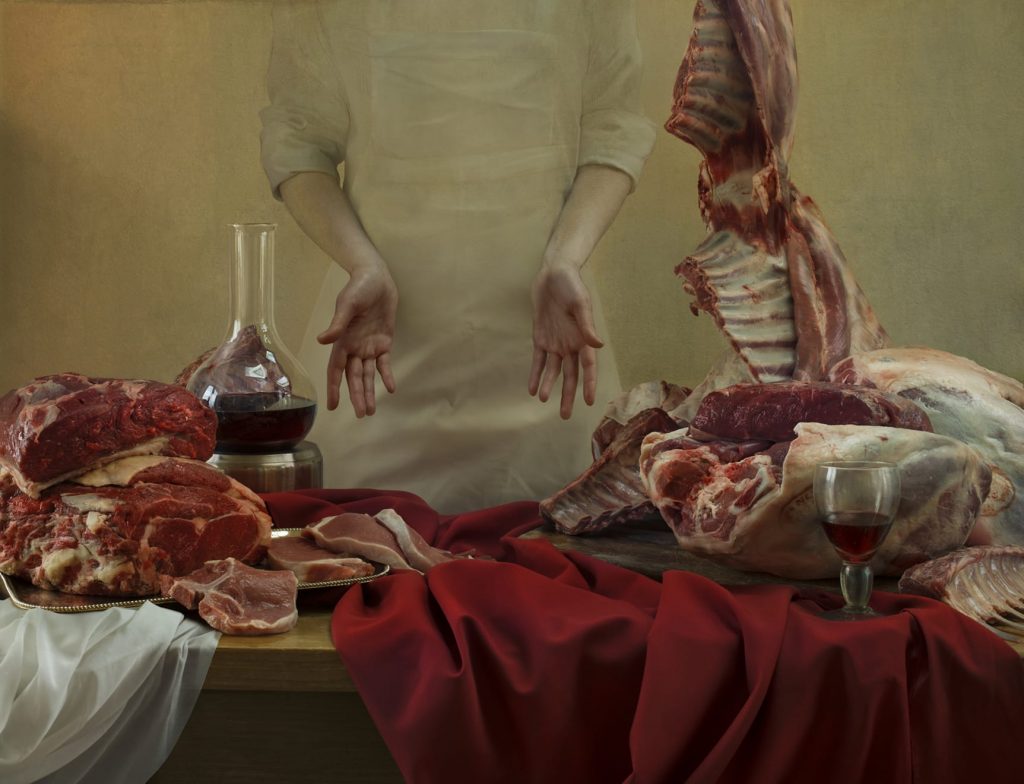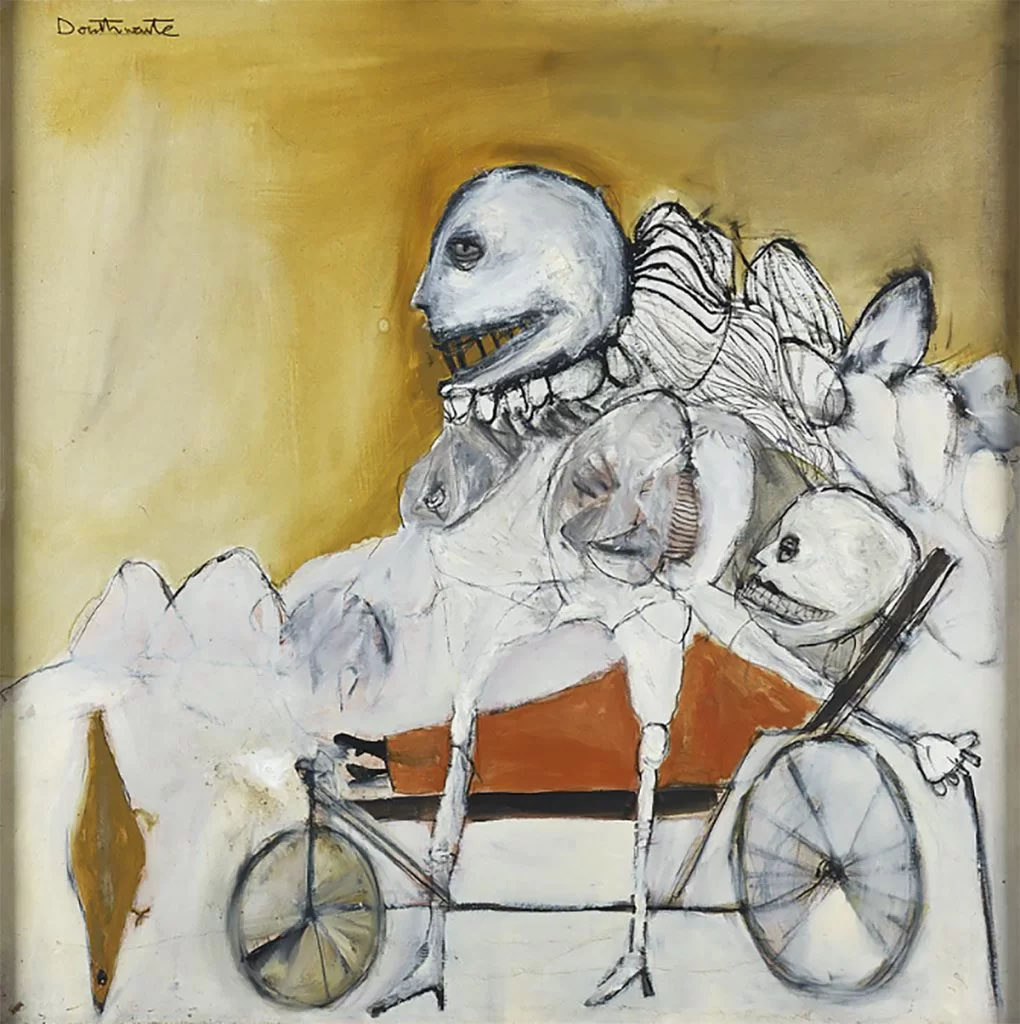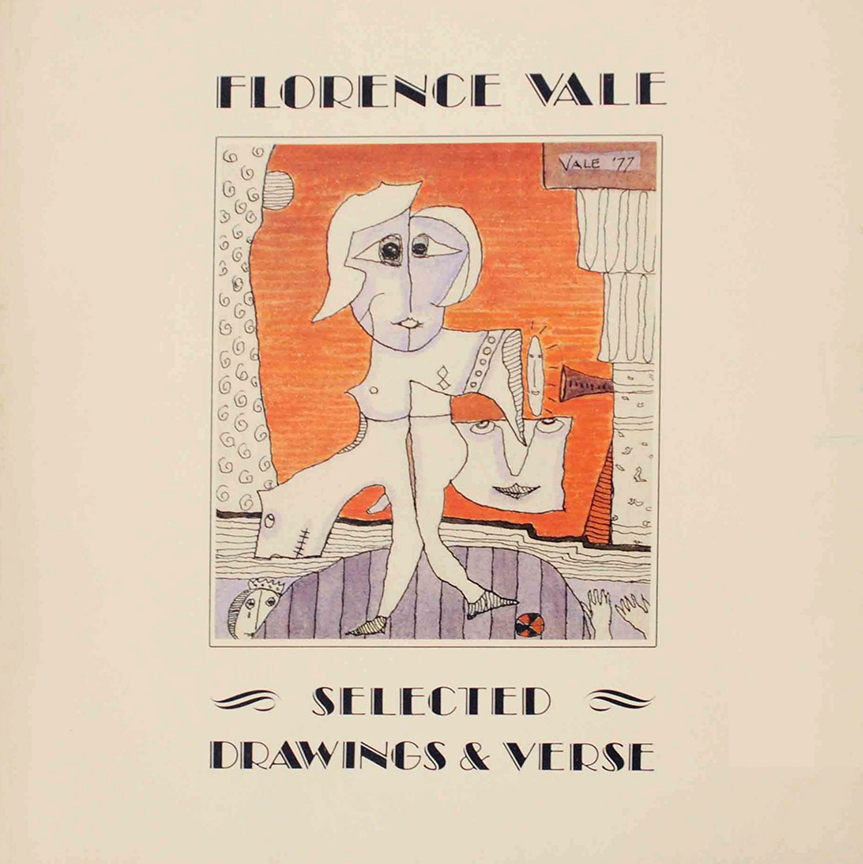In: Female painters

Katerina Belkina | The Dinner, 2016
February 15, 2024Katerina Belkina | The Dinner, 2016 (from the series Repast)
(Photography, Digital Painting)
“God sendeth and giveth both mouth and the meat.”
(Thomas Tusser, 1524 – 1580)
I will admit that there are certain fascinations (or perhaps less charitably or more directly classified) obsessions that ‘feed’ my interests in terms of artworks.
Meat – and how many artists employ flesh as inspiration or subject – is one of them. I offered a previous essay (centered on the fine paintings of Scott Conary) that explored this, but when I was making artworks prior to my exile or migration to Niagara (edit as you will) I often worked with fat, meat, bones and other organic matter, to make works that I described as ‘inappropriately beautiful.’
Sometimes, amidst the cacophony – or idiot choir – of ‘art criticism’ these days, with references pedantic and claiming to be ‘philosophical’ it is good to return to simply a notion of beauty. One of my best teachers, Patrick Traer – a fine artist whose work dealt with these contested, perhaps conflicting, narratives – spoke of this to me years ago, when I was still on the Prairies.
Belkina’s artwork that I share here is gripping, and perhaps inappropriately (to some weaker constitutions) beautiful. She offers some interesting ideas about her motivation and ideas that sometimes intersect with my own subjectivity, but this is an image that is striking and that, frankly, is enough.
Her religious connections are not of particular interest to me : but I must admit that my own religious upbringing (or indoctrination) have sometimes directed my interests, too – and there is a fecundity of potential interpretations that contest or converge that make her work worthy of consideration, whatever your pre existing assumptions (and I include myself in this statement).
From her site :
“Repast is an allegory of life cycles. Cyclicity perfectly characterizes humanity and our perception of time.
The Morning (childhood) means acquisition and accumulation. At the beginning of life we receive a certain foundation and potency both from our family and from the society in which we live. We learn to recognize the beauty around us and to feel it — we use all this for the rest of our lives. Even if “breakfast” is sparse in physical reality, it is often filled to the brim with intangible treasures such as love, fantasy, discoveries, strong impressions and first disappointments. In “breakfast” the abundance of dairy products is symbolic. The milk is associated with purity and virginity. The memories of breast milk are still fresh. The fullness you see is an exaggeration. The yellow of orange juice symbolizes concentrated emotions, the taste of life, sincere joy, and the energy of children. A lemon or an orange signifies the unquenchable thirst for action, knowledge, and discovery.
The Day (youth, adulthood) — creation, destruction, giving and taking. The flesh (the fruit) and the colour red are symbols of life and sacrifice. Youth is a period of expending — some build, others destroy. “Time to throw stones and gather stones” — there is a balance in this. We all make sacrifices and give everything at this point in our lives. More or less.
The Evening (age, completion) — contemplation, silence. A meditative part. Scarcity of dinner does not mean scarcity of life, or poverty. The table is set for one person. We come alone to the end of our lives, and yet we merge face to face with the divine in this world. It is a time of transition where all matter fades and loses all meaning. I believe our spirit reaches its peak here and we either accept or reject this transition completely. The set of elements depicted is simple: the fish is the symbol of Christ, the potato (the second bread) — the body losing the spirit (steam), the black tea — the drink of the gods and sages, not for simple thirst quenching, but for contemplation. The position of the hands in the triptych refers to Leonardo da Vinci’s “Last Supper”, in which the master emphasized the hands. Here they recede into the background and invite the viewer into this or that phase of life — past or future.”
Katerina Belkina was born in Samara in the southeast of European Russia : her mother was also a visual artist. Belkina attended the school for Photography of Michael Musorin in Samara and she’s exhibited her work in Moscow and Paris. In 2007 Katerina Belkina was nominated for the prestigious Kandinsky Prize (comparable to the British Turner Prize) in Moscow, and she has also been awarded the Hasselblad Masters Prize. She lives and works in Werder (Havel) near Berlin.
More of her work can be enjoyed here and here.
~ Bart Gazzola
Read More
Pat Douthwaite | Bernard Berenson at Leptis Magna, 1966
March 31, 2023Pat Douthwaite | Bernard Berenson at Leptis Magna, 1966
I am only a picture-taster, the way others are wine – or tea – tasters.
Bernard Berenson
Years ago when I was on a panel talking about ‘modernism’ I offered a line from Clement Greenberg, that is one of my favourites (not solely for the idea expressed, but also as it seemed to fly in the face of many of the karaoke modernists who attended that discussion on the prairies who are sure ‘art’ ended with hard edged painting several decades ago): that we evaluate artwork with the criteria we have now, but fully understanding that this criteria can and must change.
Greenberg is one of the ‘old gods’ of the Western art canon – like Bernard Berenson, the erstwhile subject of this painting by Douthwaite. The site that Berenson is ‘visiting’ in this painting is of significant archeological important (more on that can be read here). Berenson (1865 – 1959) was an American art historian specializing in the Renaissance, but his influence was much more than that, and he is one of the shoals of Western art history that is to be negotiated.
But – in deference to contested narratives, and considering how Douthwaite has, like too many female artists, not garnered the acclaim of some of her male colleagues – I also offer Atwood’s iconic line: “We were the people who were not in the papers. We lived in the blank white spaces at the edges of print. It gave us more freedom. We lived in the gaps between the stories.” Douthwaite’s paintings have a striking originality, and though she’s often compared to Chaïm Soutine he is also – like Douthwaite – an artist whose work is immediately recognizable. This painting has a carnivalesque quality to it, and the ‘skulls’ suggest a merry dance of death…. she often “referred to herself as the “high priestess of the grotesque”, aptly describing her dedication to the arresting, often haunting, figurative work that carved out her place within British postwar art…[Douthwaite] was a distinctive and complex artist rather than [simply] a “difficult” woman, as she was sometimes described.” (from here)
Douthwaite’s approach is unique: ‘Instead of the traditional easel set up, Douthwaite preferred to paint on the floor: ‘I crawl around the floor on my knees, with a butcher’s apron round me, moving from drawing to drawing or canvas to canvas.’ She was unconventional in her painting technique too and rather than use brushes she worked the images up from the surface of the canvas using paint-soaked rags. She often depicts death with humour as if to underline the absurdity of life.’ (from here)
Pat Douthwaite was born in Glasgow in 1939 and initially studied mime and modern dance with Margaret Morris. She is primarily self taught, though in 1958 Pat lived in Suffolk with a group of painters. From 1959 to 1988 she travelled widely (North Africa, India, Peru, Venezuela, Europe, USA, Kashmir, Nepal, Pakistan, Ecuador) and from 1969 lived part of the time in Majorca. Douthwaite exhibited with the Women’s International Art Club in London between 1960 and 1966. She returned to spend the rest of her life in Scotland, passing away in 2002 at Dundee. In 2005 the Scottish National Gallery in Edinburgh mounted a memorial exhibition to mark her life and work.
Much more of her work can be seen here, and more about her life can be learned here.
~ Bart Gazzola
Read More
Shani Rhys James | Woman Smoking, 2011
March 7, 2023Shani Rhys James | Woman Smoking, 2011
“If painting doesn’t offer a way to dream and create emotions, then it’s not worth it.” (Pierre Soulages)
“Through the dialogue between paint and word, issues of domesticity, rootlessness and the relationship between women and the home will arise within the claustrophobic space, revealing how the places in which we live can say so much about who we are.” (Karen Price, from here)
There is a directness to James’ paintings – her moments that are both captured and created – of everyday, potentially ordinary scenes that is belied by her facility in paint. The physicality of the medium as employed by James’ is reminiscent of Lucian Freud (“She lathers and slathers on the paint with a kind of unrestrained glee” asserts Michael Glover), and the charged nature of what she presents to us is of the same ilk. Something has just happened, or is about to happen: there’s a quietus here, portentous and mildly unnerving.
The tight compositions of figures in rooms that seem suffocating were also a factor in the many works that James made about life during COVID lockdowns: “The claustrophobia of the interior is a metaphor for that frustration of being unable to express deep feelings of creativity, or to be involved in pertinent worldly issues.”
James also offers – not about this painting specifically, but applicable here that “my over-scaling of flowers [in the wallpaper] evokes either a cloying or menacing atmosphere, both repellent and seductive.” (from here)
Shani Rhys James is originally from Australia, but has lived and worked in Wales for since 1984. A more complete history can be read here.
If I may inject a touch of subjectivity, with the disclaimer that my mind often goes to dark places: when looking upon James’ people, I was reminded of an exchange in Margaret Laurence’s The Diviners, where the painter Dan McRaith finally shares some of his work with the main character Morag Dunn. McRaith figures, in the Gunn’s initial response, have ‘eyes [that] seem distanced, distorted–no, not distorted; the flesh mirrors the spirit’s pain, a greater pain than the flesh even if burned could feel. A grotesquerie of a woman, ragged plaid-shawled, eyes only unbelieving empty sockets, mouth open in a soundless cry that might never end, and in the background, a burning croft. Morag turns and looks at him, after looking at this last painting. “The dispossessed.”’
“Shani Rhys James is arguably the most exciting and successful Welsh painter of her generation. Her considerable reputation, both in Wales and beyond, continues to grow apace. She has exhibited with Martin Tinney Gallery since 1993 and subsequently her work has appeared in exhibitions throughout Britain and mainland Europe. William Packer, the distinguished art critic, has spoken of her as a painter of remarkable power, whose paintings are as convincing as anything currently being produced in Britain.” (from here, where you can see more of her fine works and learn about her many accomplishments)
Shani Rhys James’ site is here. She can be found on IG here.
~ Bart Gazzola
Read More
Haruko Maeda | Self – Portrait with my cat and my grandmother in a glass, 2020
December 2, 2022Haruko Maeda | Self – Portrait with my cat and my grandmother in a glass, 2020
Several years ago, when I was going through the library of a recently deceased friend – at the invitation of his daughter – I noticed in his (former) apartment that she had a velvety bag, looking lustrous and fancy. I asked if this was some expensive alcohol, to mark her father’s passing. She told me it was her father’s ashes. When I asked if they’d be scattered in the city we were in, as he’d lived there for some time, contributing to the critical writing community and being a significant voice around visual culture and especially photography, or back in his home province in the Maritimes, she tersely commented she had not decided yet whether they’d be flushed down the toilet or mixed in with the cat litter.
When my own father passed several years ago, not long before COVID, the arrangements around his inurnment were put on hold: his ashes sat on a shelf in the living room of what is now my mother’s house for some time, only recently being put underground this past summer. Frankly, having ‘him’ in the same room where he spent most of the final years of his life seemed to comfort my mother: he was more agreeable than he’d been in decades, ahem.
No, I am not smiling – my face is as stoic and unreadable as Maeda’s, in her painting.
Those are both dark places to begin in considering Haruko Maeda’s painting Self – Portrait with my cat and my grandmother in a glass: but the funerary rites and rituals of family are nothing if not contested narratives that bring feelings to the surface, re opening old wounds and making new ones. Leave the dead to bury the dead, they (Matthew and Luke, to be specific, but that may just be hyperbole) say, but they never truly ‘leave’ us….
Maeda looks unperturbed in this scene: her cat seems relaxed, and even the fly that perches upon her arm that holds the ashes of her grandmother is subtle.
“Japanese Haruko Maeda lives and works in Austria since 2005. In her art she combines the Shintoistic traditions of her homeland with the Roman Catholic faith, deeply rooted in Austrian culture and history. This allows her to position herself between East and West. Maeda lets these double belongings function as a kind of filter through which she can process her own memories and experiences. The purpose is to raise universal questions about existence, life and death.” (from here)
In Neil Gaiman’s Sandman series, the final story arc – The Wake – offers several vignettes as concluding narratives about death, loss and mourning. One of these involves a man cast into exile, after the death of his son, who gets lost in a desert that his guides will not name, as to do so is to invite disaster. Master Li finds a tiny kitten as a companion, a ward, perhaps, against the ghosts of the dead he encounters in the ashy, shifting sands. At some point he encounters the shade of his son, and this is their conversation:
“Father? I am your son. That is only a kitten. Why do you abandon me to chase after it?”
“When you were alive, you were all my joy. Now you are dead. I see you only in my dreams. And when I awake my pillow is wet with tears. The kitten is living, and it needs my help.”
There is a solemnity to Maeda’s work, but also just a touch of irreverence.
More of Haruko Maeda’s work can be seen here.
~ Bart Gazzola
Read More
Florence Vale | Selected Drawings & Verse, 1979
November 3, 2022Florence Vale | Selected Drawings & Verse, 1979
Published by Aya Press, Toronto, Ontario, Canada, 1979
My love created
something more real than you are
how disappointing
Florence Vale was an artist influenced equally by surrealism, expressionism and cubism, melding these sometimes disparate movements into unique works. “I paint what I dream,” Florence Vale (1909 – 2003) stated, and the late art historian Natalie Luckyj offered that “Her art was a world in which fantasy and reality are interwoven to create a private and secret environment.”
She published several books of her writing intermixed with her artwork: in this slim volume, the drawings are linear and simple, and often erotic. The text alternates between a light-hearted salaciousness and more stark, desolate meditations upon love.
Vale was a previously featured artist in AIH Studios’ ongoing series of Artists You Need To Know. That can be enjoyed here, where you can see more of her artwork.
A light went out
and I can’t turn it on
the dark is frightening
engulfing
temptation is rife
a momentary relief
leaving regrets
and the pain is there still
but deeper now
despair strains the heart
longing is agony
God’s love cannot compensate for yours
This is not an easy book to find, though you may be able to procure it online through spaces like this one. But – as I so often do – I would suggest your local library, or a local second hand book store, as they have been – and continue to be – treasure troves of fine art books. I discovered this book in the library at AIH Studios, but also have a copy of another of Vale’s publications of prose and pictures that I bought at an artist run centre’s ‘yard sale.’
I must also inject that there are too few collections of artists’ books and publications that are accessible to all, in gallery and museum spaces, and this is an unfortunate consequence of the prevalence of digital spheres, now….
~ Bart Gazzola
Read More
Recent Comments